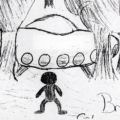Black holes are the ultimate source of clean energy. They can convert a substantial fraction of the rest mass of any trash thrown into them to pure energy, with an efficiency larger by orders of magnitude than that of nuclear reactors.
The terrestrial politics surrounding nuclear energy suggests the possibility that extraterrestrial technological civilizations may have wished over the past billions of years to harness black holes for both peaceful energy production and military weaponization programs.
Fortunately for those who favor interstellar peace, there is a major practical hurdle for manufacturing black holes technologically.
In 1972, Kip Thorne formulated the Hoop Conjecture, stating that an imploding object of mass M forms a black hole when, and only when, a circular hoop with the Schwarzschild radius, 2GM/c^2, surrounds the object in all orientations, implying that the mass is enclosed within the Schwarzschild sphere. The physicist Karl Schwarzschild was the first to derive the black hole solution to Albert Einstein’s equations of General Relativity in 1916, with an event horizon located at that radius. The Schwarzschild sphere represents the ultimate prison walls from where even light cannot escape, making the interior appear black to an outside observer. For the mass of the Sun, the Schwarzschild radius is 3 kilometers.
The Hoop Conjecture implies that in making a black hole, matter or radiation must be compressed to a minimum mass density equal to the black hole mass divided by the volume of its Schwarzschild sphere. This density is ten times higher than the density of an atomic nucleus for a black hole of the mass of the Sun. With our current technological devices, it is impossible to compress large quantities of matter or radiation to this density.
However, the density threshold for making a black hole declines inversely with mass squared and is below nuclear density for a black hole that is a few times more massive. Indeed, nature realizes these densities through the collapse of the cores of massive stars. This was confirmed by the detection of 90 merger events of black holes above a few solar masses with the LIGO-Virgo-KAGRA gravitational-wave observatory. This formation channel is also flagged by gamma-ray bursts, which are emitted by jets that form during the collapse of massive stars to black holes at cosmological distances.
Herein lies the reason for interstellar peace: black holes are not weaponized because to make them below nuclear density by conventional means requires a huge amount of mass, larger than a few times the mass of the Sun. It is an insurmountable engineering project to process such a large mass by technological means.
Particle colliders do reach energy densities beyond that of an atomic nucleus but only for a tiny amount of mass. As a result, they are a far cry away from satisfying the Hoop Conjecture.
But let us consider a more practical recipe of the type found in cookbooks. Suppose we wished to make a black hole by pouring water into a large enough region. How large would the region need to be before a black hole would form? The Schwarzschild hoop, in that case, is roughly the orbit of Mars around the Sun, and the resulting black hole would have the mass of a hundred million Suns. Unfortunately, this recipe requires more than all the water in the Milky Way galaxy.
Interestingly, supermassive black holes of this mass do form in the early Universe. A new paper just reported X-ray emission from a black hole of this mass at a redshift of 10.3, merely 500 million years after the Big Bang. This novel discovery implies that the seeds of black holes were massive early on in the Universe.
In 1994, I published a paper with Fred Rasio suggesting the early formation of massive black holes from the collapse of supermassive stars, which likely form out of the pristine gas of hydrogen and helium that came out of the hot dense phase after the Big Bang. In 2003, I substantiated this proposal in a paper with Volker Bromm, where we demonstrated that primordial gas clouds of millions of solar masses could have directly collapsed to make seed black holes if molecular hydrogen cooling had been suppressed in them. This became a popular idea in subsequent decades and was dubbed as the channel for Direct Collapse Black Holes.
Going even further back in time, the very early Universe could have produced primordial black holes if some regions on the scale of the early cosmic horizon had large enough concentrations of mass to satisfy the Hoop Conjecture, for example, as a result of phase transitions. Primordial black holes in the mass range between asteroids and the Moon could then account for the dark matter, but so far, we have not found any evidence for them.
For all we know, nature makes black holes between a few and tens of billions of solar masses. These powerful lighthouses shine throughout cosmic history. We owe our thanks to the Hoop Conjecture for preventing advanced civilizations from weaponizing black holes.
Avi Loeb is the head of the Galileo Project, founding director of Harvard University’s – Black Hole Initiative, director of the Institute for Theory and Computation at the Harvard-Smithsonian Center for Astrophysics, and the former chair of the astronomy department at Harvard University (2011-2020). He chairs the advisory board for the Breakthrough Starshot project, and is a former member of the President’s Council of Advisors onScience and Technology and a former chair of the Board on Physics and Astronomy of the National Academies. He is the bestselling author of “Extraterrestrial: The First Sign of Intelligent Life Beyond Earth” and a co-author of the textbook “Life in the Cosmos”, both published in 2021. His new book, titled “Interstellar”, is scheduled for publication in August 2023.

